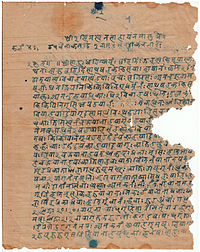

| Nepalese scripts
| |
|---|---|
 | |
| Script type | |
| Direction | Left-to-right |
| Region | Nepal and India |
| Languages | Nepal Bhasa |
| Related scripts | |
Parent systems | |
Child systems | Ranjana, Bhujimol, Pracalit |
| This article contains phonetic transcriptions in the International Phonetic Alphabet (IPA). For an introductory guide on IPA symbols, see Help:IPA. For the distinction between [ ], / / and ⟨ ⟩, see IPA § Brackets and transcription delimiters. | |
| Brahmic scripts |
|---|
| The Brahmi script and its descendants |
|
Northern Brahmic |
|
Southern Brahmic
|
|
|
Nepalese scripts (Nepal Lipi: 𑐣𑐾𑐥𑐵𑐮 𑐁𑐏𑐮, Devanagari: नेपाल आखल) are a family of alphabetic writing systems employed historically in Nepal Mandala by the indigenous Newar people for primarily writing Nepal Bhasa. It is also used for transcribing Sanskrit and Pali.[2] There are also some claims they have also been used to write the Parbatiya (Khas) language[3][dubious – discuss].
These scripts were in widespread use from the 10th to the early 20th-century, but have since been largely supplanted by the modern script known as Devanagari. Of the older scripts, about 50,000 manuscripts written in Nepal Lipi have been archived.[4]





Prior to development of Nepal Scripts, people in the Nepal Mandala used the following scripts which are shared within the South Asian region.[5][6]
The 'Nepal Script' or 'Nepalese script'[10] appeared in the 10th century. The earliest instance is a manuscript entitled Lankavatara Sutra dated Nepal Era 28 (908 AD). Another early specimen is a palm-leaf manuscript of a Buddhist text the Prajnaparamita, dated Nepal Era 40 (920 AD).[11] One of the oldest manuscript of Ramayana, preserved till date, was written in Nepal Script in 1041.[12]
The script has been used on stone and copper plate inscriptions, coins (Nepalese mohar), palm-leaf documents and Hindu and Buddhist manuscripts.[13][14]
Among the famed historical texts written in Nepal Lipi are Gopalarajavamsavali, a history of Nepal, which appeared in 1389 AD,[15] the Nepal-Tibet treaty of Nepal Era 895 (1775 AD) and a letter dated Nepal Era 535 (1415 AD) sent by Chinese Emperor Tai Ming to Shakti-simha-rama, a feudatory of Banepa.[16][17]
Besides the Kathmandu Valley and the Himalayan region in Nepal, the Ranjana script is used for sacred purposes in Tibet, China, Japan, Korea, Mongolia, Bhutan, Sikkim and Ladakh.[18]
The Jokhang Temple in Lhasa, Tibet is ornamented with mantras embossed in Ranjana script, and the panels under the eaves are numbered using Nepal Lipi.[19]
In 1906, the Rana regime banned Nepal Bhasa, Nepal Era and Nepal Lipi from official use as part of its policy to subdue them, and the script fell into decline. Authors were also encouraged to switch to Devanagari to write Nepal Bhasa because of the availability of moveable type for printing, and Nepal Lipi was pushed further into the background.[20] However, the script continued to be used for religious and ceremonial purposes till the 1950s.
After the Rana dynasty was overthrown and democracy established in 1951,[21] restrictions on Nepal Bhasa were lifted. Attempts were made to study and revive the old scripts,[22] and alphabet books were published. Hemraj Shakyavamsha published an alphabet book of 15 types of Nepalese alphabets including Ranjana, Bhujimol and Pachumol.[23]
In 1952, a pressman Pushpa Ratna Sagar of Kathmandu had moveable type of Nepal script made in India. The metal type was used to print the dateline and the titles of the articles in Thaunkanhe monthly.[24]
In 1989, the first book to be printed using a computer typeface of Nepal script, Prasiddha Bajracharyapinigu Sanchhipta Bibaran ("Profiles of Renowned Bajracharyas") by Badri Ratna Bajracharya, was published.
The scripts known to have been used by the Newar people of pre-Gorkha Nepal (i.e., Nepala Mandala) or dynasties that ruled over them in history are as follows:[5][6]
Among the different scripts based on Nepal script, Ranjana (meaning "delightful"), Bhujinmol ("fly-headed") and Prachalit ("ordinary") are the most common.[25][26] Ranjana is the most ornate among the scripts. It is most commonly used to write Buddhist texts and inscribe mantras on prayer wheels, shrines, temples, and monasteries. The popular Buddhist mantra Om mani padme hum (meaning ("Hail to the jewel in the lotus" in Sanskrit) is often written in Ranjana.
| Pracalit | Rañjanā | Dev. | Rom. |
|---|---|---|---|
| क | ka | ||
| ख | kha | ||
| ग | ga | ||
| घ | gha | ||
| ङ | ṅa | ||
| ह्ङ | ṅha | ||
| च | ca | ||
| छ | cha | ||
| ज | ja | ||
| झ | jha | ||
| ञ | ña | ||
| ह्ञ् | ñha |
| Pracalit | Rañjanā | Dev. | Rom. |
|---|---|---|---|
| ट | ṭa | ||
| ठ | ṭha | ||
| ड | ḍa | ||
| ढ | ḍha | ||
| ण | ṇa | ||
| ह्ण | ṇha | ||
| त | ta | ||
| थ | tha | ||
| द | da | ||
| ध | dha | ||
| न | na | ||
| ह्न | nha |
| Pracalit | Rañjanā | Dev. | Rom. |
|---|---|---|---|
| प | pa | ||
| फ | pha | ||
| ब | ba | ||
| भ | bha | ||
| म | ma | ||
| ह्म | mha | ||
| य | ya | ||
| र | ra | ||
| ह्र | rha | ||
| ल | la | ||
| ह्ल | lha | ||
| व | va |
| Pracalit | Rañjanā | Dev. | Rom. |
|---|---|---|---|
| श | śa | ||
| ष | ṣa | ||
| स | sa | ||
| ह | ha | ||
| क्ष | kṣa | ||
| त्र | tra | ||
| ज्ञ | jña |
The compound letters kṣa, tra and jña are often regarded as separate letters that are taught together with the other letters. Since the Newari language lacks retroflex consonants, the letters ṭa, ṭha, ḍa, ḍha, ṇa and ṣa are used only in loanwords. The same applies to the letter śa. Newari, on the other hand, has a number of sonorant consonants that are pronounced with creaky voice (ṅha, ñha, ṇha, nha, mha, rha and lha). They are written in compound letters consisting of "ha" combined with the letter for the corresponding modal sonorant.[27]

Some letters have alternative forms that are used when combined with certain vowel diacritics or included in a consonant cluster.[28]
Consonant clusters are written by writing several consonant letters together in complex ligatures. How they are written depends on the shape of the letters and some letters have alternative shapes that are used depending on their position in the cluster.[28]
| Pracalit | Rañjanā | Dev. | Rom. |
|---|---|---|---|
| अ | a | ||
| आ | ā | ||
| इ | i | ||
| ई | ī | ||
| उ | u | ||
| ऊ | ū |
| Pracalit | Rañjanā | Dev. | Rom. |
|---|---|---|---|
| ऋ | ṛ | ||
| ॠ | ṝ | ||
| ए | e | ||
| ऐ | ai | ||
| ओ | o | ||
| औ | au |
| Pracalit | Rañjanā | Dev. | Rom. |
|---|---|---|---|
| अय् | ay | ||
| आय् | āy | ||
| एय् | ey |
The vowel ṛ which in Sanskrit stands for syllable forming [ṛ] is used in Newar script to write the syllable ri.
In Newari, the vowels a and ā are pronounced with different vowel qualities. In order to write their long equivalents, some diacritics have been given partially different properties than what is otherwise usual in Brahmic scripts.
| Letter | Name | Transcription | Description | |||
|---|---|---|---|---|---|---|
| Pracalit | Rañjanā | Sanskrit | Newari | Dev. | Rom. | |
| visarga | lyuphuti | अः | aḥ | Usually used to indicate that a vowel is followed by an h-sound. In Newari it is used instead of marking a long vowel. | ||
| candrabindu | milaphuti | अँ | am̐ | Marks a nasal vowel. | ||
| anusvāra | sinhaphuti | अं | aṃ | In other words, it can be seen as a combination of visarga and chandrabindu. | ||
Some of the vowel diacritics have different appearances depending on whether the consonant has a top line or not. There are seven consonants without top lines: ga, ña, ṭha, ṇa, tha, dha and śa.[28]
| a | aḥ | ā | āḥ | i | ī | u | ū | ṛ | ṝ | e | ai | o | au | am̐ | aṃ | |
|---|---|---|---|---|---|---|---|---|---|---|---|---|---|---|---|---|
| क ka |
||||||||||||||||
| ग ga |
The vowel dialects can have up to three different appearances depending on which consonant they are combined with.[29] The rules for ka are also used for ja, kṣa and jña. The rules for ga also apply to kha, ña, ṭha, ṇa, tha, dha and sha. The rules for ba are used for other letters.
Nepal Lipi is available in Unicode as Newa script. It is the official script used to write Nepal Bhasa. Ranjana script has been approved for encoding in 2021. [30]
The letter heads of Kathmandu Metropolitan City,[31] Lalitpur Metropolitan City,[32] Bhaktapur Municipality,[33] Madhyapur Thimi Municipality[34] ascribes its names in Ranjana Script.
In India, the official script for Newar language is Nepal Lipi.[35]
{{cite journal}}: Cite journal requires |journal= (help)
The encoding for Siddham is to serve as a unifying block for all regional variants of the script, such as 'Siddhamātṛkā' and 'Kuṭila'. The representative glyphs are based upon Japanese forms of Siddham characters on account of active usage of the script by Japanese Buddhist communities
{{cite news}}: Missing or empty |title= (help)